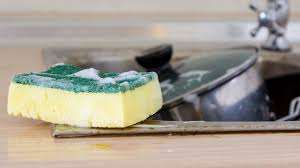
Practice good dishrag etiquette.
Your dish rags are really no better than your sponges. And like sponges, using a dirty dish rag to clean a kitchen countertop will only spread germs. Your best bet is to replace rags about once a week. "Allow them to dry out between uses because most bacteria thrive only in moistness," Schachter says. In fact, they can only survive a few hours on dry surfaces. "Rags should be washed in the washing machine and then dried on high heat," he says.
Zap away bugs.
Kitchen sponges are the No. 1 source of germs in the whole house. Why? The moist, micro-crevices that make a sponge such an effective cleaning device also make it a cozy home for germs and more difficult to disinfect. Wiping your counters or dishes with a dirty sponge will only transfer the bacteria from one item to another. "Wet your sponge and then pop it in the microwave for two minutes to eliminate the germs that lurk inside the crevices," says Neil Schachter, MD, medical director of respiratory care at Mount Sinai in New York City, and the author of The Good Doctor's Guide to Colds and Flu .
Wipe away germs.
Faucet handles, refrigerator door handles, and doorknobs are next on the list of kitchen culprits that aid and abet germs. Use disinfectant spray or wipes on sink faucets, refrigerator handles, stove handles, cupboard handles, trashcans, doorknobs, and any other area that you touch with your hands. "These sprays or wipes kill germs on contact," explains Schachter. "This is really important and should be done several times a day before and after touching these objects," he says. "Don't forget to wipe down the telephone," adds Charles Gerba, PhD, a professor of microbiology at University of Arizona in Tucson.
Clean the cutting board.
Cracks and crevices in your cutting board provide plenty of space for bacteria to grow. "The average cutting board has about 200% more fecal bacteria than the average toilet seat," Gerba says. "People don't disinfect cutting boards," he says, and they should. "Don't cut up chicken and then salad on the same cutting board without disinfecting it," he stresses. Better yet, "use separate boards for raw meat and making salads." Plus, he says it's important to clean and disinfect inside the fridge, microwave, cupboards and other surfaces that come into frequent contact with food.




 Ghana will make maiden voyage into space should Bawumia become President — Chair...
Ghana will make maiden voyage into space should Bawumia become President — Chair...
 Train crash: Despite the sabotage, we shall not be deterred and will persevere —...
Train crash: Despite the sabotage, we shall not be deterred and will persevere —...
 Tema-Mpakadan railway project a perversion of the original viable concept design...
Tema-Mpakadan railway project a perversion of the original viable concept design...
 Train crash: Elsewhere, everyone involved in the test will either be fired or re...
Train crash: Elsewhere, everyone involved in the test will either be fired or re...
 Ghana, other election bound-countries must build fiscal buffers – IMF admonishes
Ghana, other election bound-countries must build fiscal buffers – IMF admonishes
 Parliament reconvenes late May, denies Speaker Bagbin delaying recall over NDC t...
Parliament reconvenes late May, denies Speaker Bagbin delaying recall over NDC t...
 $100m needed to revitalise Ghana's poultry sector — GNAPF
$100m needed to revitalise Ghana's poultry sector — GNAPF
 Driver arrested for causing train collision on Tema-Mpakadan Railway Line
Driver arrested for causing train collision on Tema-Mpakadan Railway Line
 Police grab trucker for Tema-Mpakadan rail accident
Police grab trucker for Tema-Mpakadan rail accident
 Gov't plans to revise traditional customs following Gborbu child marriage
Gov't plans to revise traditional customs following Gborbu child marriage
